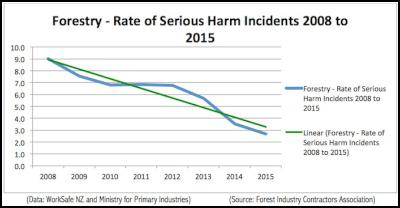Dramatic improvement in forest industry safety record
Dramatic improvement in forest industry safety record
Following a spate of workplace deaths in 2013, New Zealand’s forestry industry has set a shining example in improved safety performance nationally over the past three years. Annual serious harm incident rates dropped in half over the past two years. The numbers dropped from 160 incidents in 2013, to 107 in 2014 and then to 79 in 2015.
Even more striking – the rate of serious harm in production forestry has dropped to less of one-third of the rate in 2008. This is based on annual forest harvest volumes lifting from less than 20 million cubic metres per annum to over 30 million in that period.
Figure 1: Reduced Forestry Serious Harm from 2008 through 2015

From June 2013 forest industry leaders from forest management and contracting convened an action group. This led co-funding an independent working party to conduct a national review that made recommendations during 2014 on key issues to be addressed to reduce workplace harm across the forest industry.
• Leaders in both industry and government acted decisively on the advice of the Independent Forest Safety Review to boost safety resources and take key actions.
• During 2015 forest manager and contractor leaders, including worker representatives, formed the Forest Industry Safety Council (FISC). FISC was fortunate to recruit Dame Alison Paterson as chair and Fiona Ewing as safety director. They have taken a practical and inclusive approach with all industry stakeholders. A comprehensive Injury prevention programme has been set up based on risk assessment and incident data.
• Coincidental with the safety review and safety council formation forest industry leaders showed considerable leadership to take new technology in mechanised harvesting onto the most dangerous tree-felling workplace. Traction assisted harvesters are now replacing manual tree fallers wherever possible in corporate forests. These machines isolate workers from the key risks in tree falling.
• Since 2013 over $70 million has been invested in new harvesters capable of working on forests on steep slopes. Machinery technology and developments continue to be led by forest contractors and local manufacturers with close communication, backing and support of the forest managers they work with.
• As a result of both increased injury prevention funding work and mechanisation, the rate of serious harm incidents in forestry has dropped dramatically and constantly since 2008, This is measured against annual roundwood removals from data collected by WorkSafe NZ (formerly Department of Labour) and Ministry of Primary Industries. (Refer Figure 1.)


 Gordon Campbell: On bird flu, AUKUS entry fees and Cindy Lee
Gordon Campbell: On bird flu, AUKUS entry fees and Cindy Lee NZ Government: New Lab To Help Protect Key Pacific Tuna Fisheries
NZ Government: New Lab To Help Protect Key Pacific Tuna Fisheries Susan Botting - Local Democracy Reporter: Ruawai Leader Slams Kaipara Council In Battle Over $400k Property
Susan Botting - Local Democracy Reporter: Ruawai Leader Slams Kaipara Council In Battle Over $400k Property Te Pati Maori: Another ‘Stolen Generation’ Enabled By Court Ruling On Waitangi Tribunal Summons
Te Pati Maori: Another ‘Stolen Generation’ Enabled By Court Ruling On Waitangi Tribunal Summons Peace Action Wellington: Die In for Palestine Marks ANZAC day
Peace Action Wellington: Die In for Palestine Marks ANZAC day Labour Party: Penny Drops – But What About Seymour And Peters?
Labour Party: Penny Drops – But What About Seymour And Peters? Government: PM Announces Changes To Portfolios
Government: PM Announces Changes To Portfolios


